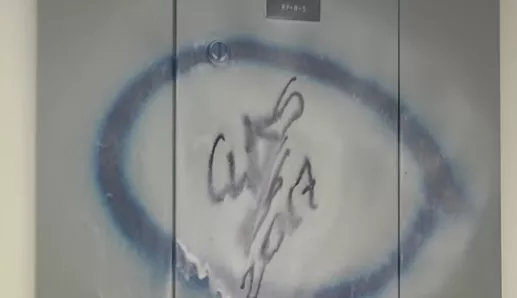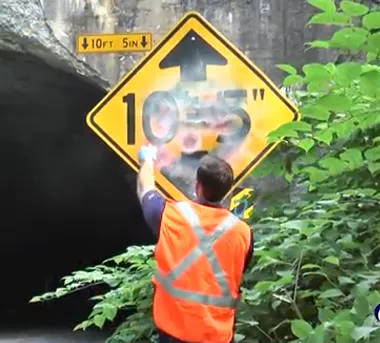After watching hours of renovation shows on television, you’ve taken the term “houseproud” to a whole new level. You’ve ripped out the kitchen and updated the master bathroom. You even hired professional landscapers. The curb appeal is off the charts.
But then a vandal hits your garage door with a can of spray paint! What to do? The Property Brothers haven’t covered this topic yet. Graffiti may have started as an urban blight, but it has spread to the suburbs and beyond. Nobody’s home is safe.

When faced with this unfortunate situation, you could hire a company that specializes in this type of cleaning. But ask yourself, “What would Mike Holmes do?” He’d take it as a challenge to remove the graffiti himself—or at least try. There are several cleaning products to tackle the problem. Here, we channel the spirit of HGTV and provide helpful hints for erasing the damage.
Faster is better
What are you waiting for? Get outside and start this job as soon as possible, before the paint dries and takes hold. Try to remove graffiti within the first 24 to 48 hours. You won’t regret getting a head start the same day.
It’s all about the (spray) paint
Graffiti vandals have a variety of inks and paints in their toolkits. The trick is choosing the right cleaning product according to the age of the graffiti, the type of garage door and the type of ink or paint. Some spray paints are water based and others oil based. Street artists (a.k.a. the vandals) often use low‑quality paints which are notably easier to remove. If it was done with a marking pen, enamel paint, or permanent ink, the graffiti is much more difficult to remove. It helps to use the right solvent.

A lesson in chemical solvents
A solvent is a chemical substance that dissolves something else—in this case, spray paint. There are three types of solvents:
- Oxygenated solvents, with higher solvency power. Examples include alcohols, ketones and glycol ethers.
- Hydrocarbon solvents such as paraffin, with lower solvency power but they effectively separate from water.
- Halogenated solvents, which typically belong to the family of chlorinated chemicals.
Okay, that’s the chemistry. Here what you need to know. Strong solvents will take off the paint under the graffiti, as well as the tag, if you’re not careful. You can’t expect a solvent to distinguish between the graffiti and your undercoat of exterior paint on the garage door. Knowing that, proceed with caution, don’t over‑saturate the stain with solvent, scrub lightly and be sure to work in small areas. (Note that wooden doors are particularly vulnerable to solvents).
Solvent options
Try mineral spirits, also called white spirits. They’re a type of petroleum distillate used to thin paint. Note that they’re cheap and easy to use, but doesn’t always remove more stubborn graffiti. White spirits will only work on easy‑to‑remove, fresh paint that can be removed with a pressure washer anyway.
Naphtha, also a petroleum solvent, is stronger than white spirits. Naphtha will dissolve dry, hardened paint and crayons.
If your vandal used markers, isopropyl alcohol is a good option. It also breaks down shoe polish and ink.
Lacquer thinner, or acetone, is one of the most effective solvents against graffiti. Acetone softens and dissolves most types of paint—even spray paint. However, acetone can soften certain types of plastic or vinyl, so it's unsuitable on a plastic garage door.
But what’s the active ingredient in professional graffiti removing products? That would be methylene chloride –a strong type of paint thinner. You can buy a paint remover that contains methylene chloride at a paint store. The products need to sit on the graffiti for somewhere between 15 and 30 minutes. This type of product is also used by companies specialized in removing graffiti and by city workers removing graffiti from public property. Think traffic signs and mailboxes.
As always, be sure to read the manufacturer's instructions for any cleaning product and use the type of brush—nylon bristle, wire brush, brillo pad or soft cloth—they recommend. Testing a small area is always advisable.

An environmentally-friendly option
If you shy away from solvents, there’s an option. “Green” activists and grandmothers swear by a mixture of white vinegar and lemon juice, or white vinegar and baking soda, is an effective cleaning agent. Admittedly, there is less of a risk that you will damage your door’s original paint. It’s worth a try.
What’s underneath the graffiti?
Your door’s original surface is a big consideration. If your garage door was manufactured with a baked‑on paint, typically polyester based, it’s more resistant. If your garage door was repainted in a paint shop by a professional painting company, find out what type of paint they used to do it and how it was applied.
Sometimes, it’s best to repaint
Is your garage door getting old? Think long and hard about spending time and money trying to scrub graffiti off a weathered door. Wouldn’t a cosmetic makeover contribute greatly to the overall appearance of your home? If so, just repaint your garage door and don’t bother hunting around town for a specialized product to remove graffiti.
For help picking the paint color for the makeover, major paint manufacturers have an online visualize tool for exterior paint on their websites, so you can experiment with color combinations and find the perfect look to complement your front door. Designers know that oversized garage doors look best in lighter shades, while smaller doors can be painted a deeper shade. Bold accent colors—red, cranberry, navy—look best on front doors.
Before you pick up the paint brush, start by thoroughly cleaning the door’s surface and bottom edge. Wash off all surface dirt, grease and spider webs before applying a coat of good-quality primer. If your door is from Garaga or is a door with a similar surface, then refer to our website for the instructions you’ll need to repaint it.
Remember your insurance policy
Perhaps your home insurance policy covers damage by vandals! Contact your insurance company to confirm and ask about the deductible. If the deductible is high, it may not be worth submitting a claim.
Is it time for an upgrade?
Ask yourself an honest question. Was your garage door ready to be replaced anyway? This could be the prodding you were waiting for to make a change. If you live near Des Moines contact us now or call 515-276-3700. We provide no‑obligation quotations by email.
Another option is to come and meet us at our showroom. Use our Design Centre to pick out the style of door and look at our image gallery for instant inspiration.

Add new comment